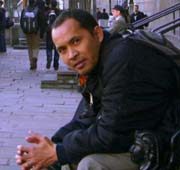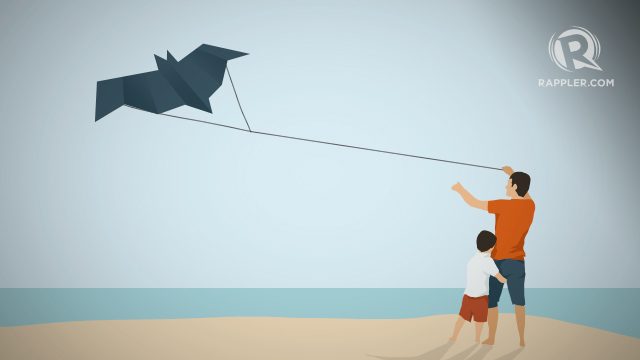SUMMARY
This is AI generated summarization, which may have errors. For context, always refer to the full article.

My 4-year old son Sioti came to me with a book on kite-making, a Christmas present given to him by a dear friend of mine.
“Tatay (father), can we do one of these,” he said, pointing to a flat kite.
As expected of a father who has not been spending as much time with his son as he should be, my response was: “Of course, big boy, we can make one, but only bigger, better, and, flies higher.”
“I want one that looks like Batman,” he said.
“Oh, we can build a Justice League made of kites,” I responded smugly.
Part of youth
But to be honest, kite-flying was a great part of my youth. I suspect that much I know now about predictions and decision-making – things that are so essential in my current work – I began to learn while flying kites.
I want my son, Sioti, to experience the pleasure that a kite brings and to discover what it teaches us about life.
Growing up in Sampaloc, Manila in the early 1980s, I remember how the summer breeze would launch a hundred kites that crowd out the azure skies. Our youthful exuberance and daring would make us climb the rooftops of apartment buildings. Homeowners were fuming mad and yelled at us to come down.
Next to the street I grew up in, there were two young siblings who were legendary for their kite virtuosity. Zorro and Lito, was how they were known to us, then in their early teens, I think. Their kites were so precious that my playmates would scrimp their school allowance to buy them.
Zorro and Lito easily calls to mind the image of the chivalrous Manfred and Lothar von Richthofen, the revered Prussian aristocrat pilot duo who ruled the skies of the Eastern Front during World War I. Their presence alone was so menacing that they could puncture the ego of kite-flyers, enough to reel their strings in and pack up.
I suspect that their reputation owes partly to the fact that their hairstyle closely resembled that of Jimmy Snuka, the famous wrestler of the time. But certainly a large part of it was their kite acumen. They are the terror of the summer skies in Sampaloc.
Fun with kites
I remember how the plucky sibling triumvirate of Jong-jong, Nolan, and Father (so called because he goes to a high school seminary) would sometimes put up a strong fight against Zorro and Lito. They have earned their own reputations too, but they don’t evoke as much ferocity. And there are few others who would own the skies from time to time such as Rollie Balasa, who was also petrifying in poker tables.

The fun with kites is not just about flying, although much of it is about that. It’s also about the line that one uses. I learned this by observing the amount of effort and meticulousness that Zorro and Lito put into their lines. They immerse the yarn (usually consisting of two 500-meter rolls) in a concoction of cola (adhesive), and pulverized fluorescent lamp.
When the concoction binds itself into the yarn, they are looped into two electric posts under the sweltering heat of the sun. They run their fingers through the lines.
It shouldn’t have lumps so that it would be seamless when it gets entangled into an opponent’s line. It shouldn’t be so thick as to be brittle. It’s razorblade-like when it gets dried. They wind the lines onto their makeshift reel made out of an empty 1 gallon can of infant formula. If they turned out to be a chemist or an engineer by now, I would be the least surprised considering their genius.
Zorro and Lito’s kites would invariably start by sweeping the skies as though they were in a reconnaissance mission. An intrepid kite-flier closes in and manoeuvres to seize the higher altitude. It’s an act of aggression.
They will do either of two things. They will wait for the aggressor to come like a haughty matador in the middle of the ring. Or, they will feign a retreat, then, in a blink of an eye, climbs up to snatch back the higher elevation. They execute a half loop by yanking the line quickly.
At this point, I would be on the ground watching the aerial combat with a rush of adrenaline. I won’t have to miss a school lunch; I’d grab the losing kite.
Their kite makes a 180-degree turn. Their line now tangles with that of their foe; they let out the line, jerking it from time to time. This produces an effect similar to that of a hacksaw thrusting itself into a drift-wood back and forth.
Thrust. Tug. Thrust. Tug. The foe runs out of line and is now sitting duck. They yank their own line a tactical equivalent of a torero’s hard thrust on a bull.
The foe’s line finally gives in, is severed from the kite which thereupon floats in mid-air like a weightless paper. Wind takes it then it begins to descend.
I spring into action. What’s the height from where the losing kite is falling? What’s the wind direction? What’s the wind speed? I sprint with my eyes fixated on the falling kite, adjusting my speed and direction. I arrive in the crash site with a dozen or so boys which are all poised for a melee.
What I lack in height and levitation, I try to make up in cunning. I look for the end of the line of the kite, which is now on a rapid descent. Everyone jumps at the same time. I find the yarn, grab, and yank it. The kite lifts up just before somebody takes a hold. Everyone’s shoulders fall. Everyone finds me holding the line. I grin from ear to ear.
Vanishing craft
Sioti and I made an elegant kite made out of outdated calendars and left over bamboo stick from our recent barbecue party. It’s shaped like a bat with a 4-feet wingspan, and it has a Batman insignia, just as I promised.
As we walk towards the beach to launch our kite, I wonder why kite-making is now a vanishing craft and kite-flying a rarity especially among kids.
It could be unseasoned rainfall during summer because of the changing climate. It could also be that tall buildings especially in metropolises have impeded the right wind range to fly kites. It could also be the ubiquitous computer games.
But I earnestly hope for its revival. Kite teaches us a lot of things about life. –Rappler.com
Dante Abaca Dalabajan is an environmental activist, academic, and public policy specialist. He is a member of the Cuyunen ethnolinguistic group and now lives with his family in Puerto Princesa City. The opinions he expresses are solely his own.
Add a comment
How does this make you feel?
There are no comments yet. Add your comment to start the conversation.